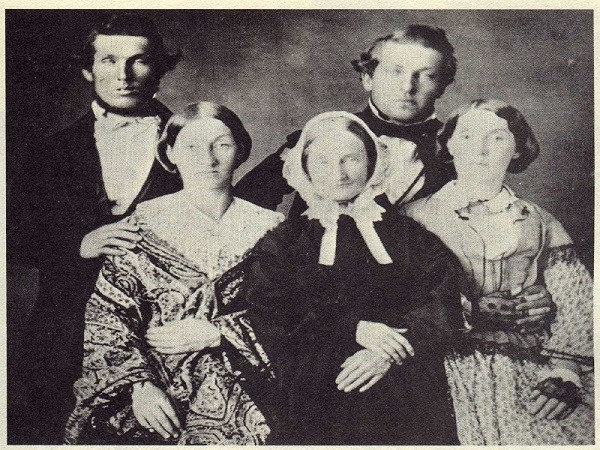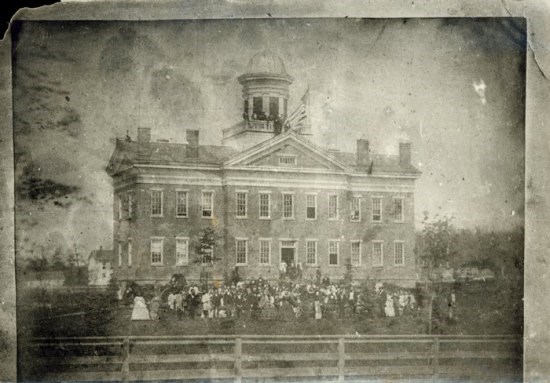Last updated: August 4, 2021
Article
The “Fine Times” of James A. Garfield’s Education, Part I

(back row at left
Touring James Garfield’s home today, one would have to try hard to overlook the fact that education and learning were important facets to the President’s life. His principal’s desk from the Western Reserve Eclectic Institute, the portraits of writers that Garfield respected such as Ralph Waldo Emerson and William Shakespeare, the books that are visible in nearly every single room – his Mentor home is full of reminders of Garfield’s fondness for learning new things. In fact, intellectualism had one of the most lasting effects on his entire life, even beyond his years as a teacher and school principal. His academic foundation and love for learning would help guide him through most events in his life, from his service in the Union Army to the very day of his inauguration as President.
Garfield in his early teens did not seem on track for the life of an educated man. He had attended district schooling at least semi-regularly and had been instructed in the subjects most students studied in the mid-19th century: reading, writing, arithmetic, and geography, as well as a few other topics if the instructor had studied and cared to teach them. He seemed to have a great fondness for reading and learning, but he was from a poor family and at the time seemed devoted to becoming a sailor. Stacking the deck against Garfield even further, there was a belief among some in the Western Reserve that excessive reading, particularly of novels, was a sort of abnormality, and some argued even a cause or sign of mental illness. Fortunately his mother Eliza and his older brother Thomas apparently did not agree, and while James was recovering from an illness acquired from working on the canal he was persuaded to try school at the nearby Geauga Seminary in Chester. The money that Garfield’s mother and brother were able to scrape together in order for James to attend school at the Seminary amounted to $17 – close to their total savings up to that point. A dollar went a lot further back then than it does today but it did not go that far, and Garfield would finish the term with a grand total of six cents.

Hiram College Archives/Wikipedia
James Garfield discovered at Geauga Seminary that he was a natural student. Apparently instruction there was not all that much different from the district schools he had attended previously – in fact, by most accounts Geauga Seminary was fairly second-rate. Earlier in life he had walked out of one district school due to a particularly weak teacher, and during his first term at Geauga he wrote home requesting his grammar book as a reference to help correct his teacher’s mistakes. Overall, though, the Seminary was a step up in his education and Garfield enjoyed his studies enough to forget his passion for sailing. The library was small with about 150 books but it was larger than what he was used to at that time. And some of the books were in Greek, likely Garfield’s first exposure to the language that would become one of his favorite subjects. He found that he excelled in algebra, at least compared to his classmates who mostly dropped out of the class by the end of the term. He also took a liking to “natural philosophy” which was that era’s name for the natural sciences. He seemed to enjoy the way science provided an answer to many everyday occurrences that one could witness firsthand.
James Garfield did not merely coast through his two years at the Geauga Seminary. “Studying” is probably the single most common word found in his somewhat sparse journal entries from this time period. He was also working hard outside of the classroom to help supplement his perpetually diminishing funds, often chopping wood and teaching district school during his time off. Undoubtedly aiding Garfield’s work ethic was the simple fact that he loved what he was doing – school was fun. Entries such as “School as usual. Fine times.” and “Studying. Fine times.” appear frequently in his diary between 1849 and 1850. On November 29, 1849, while wrapping up his first term Garfield wrote in his diary “Studying some. The thoughts of parting rend my heart. We soon must say adieu.”
From Geauga Seminary, Garfield decided to test himself further by enrolling at the new Western Reserve Eclectic Institute in Hiram, Ohio. A part of this decision was based on the fact that he did not know what he wanted to do with his life: he mostly disliked teaching children in the district schools, and while he was a capable carpenter the profession never seemed to keep his interest for long. On the other hand, he viewed a college education (or at least an advanced education) as the best way to lift himself up beyond the “herd”. The Geauga school seemed to have done much for his confidence, at least. Thomas Munnell, the teacher of Latin at the Eclectic, remembered the following about James Garfield, shortly after he first enrolled at the school in the fall of 1851:
“When he arrived he had studied a little of Latin grammar, but had done nothing in the way of translating. I had no class to suit him in elementary Latin, one being behind him, and another far in advance. He resolved at once to overtake the advanced class, provided I would hear his recitation after class hours, which I readily agreed to do.” (History of Hiram College, 1850-1900 by F.M. Green). Garfield’s self-confidence was apparently well-placed, as he was asked to give the valedictory address his first year at the Eclectic.

Lake County Historical Society
Money was again a concern at the Eclectic. During the first term he had just enough saved up from teaching and carpentry work that he was able to pay his way. His second term he worked as a janitor for the school (sweeping, ringing the bell, and building fires for heat) and in between terms he again worked as a teacher. Besides monetary concerns, every year James and his fellow students had to deal with crowded housing. Most housing at the Eclectic was provided by the community itself, which was fairly small, and it was a problem finding enough space for the 300-500 students each year. Zeb Rudolph, Garfield’s future father-in-law, often had ten students in his seven-room Hiram house. The institution attempted to build boarding houses but the option was apparently never popular with the students and the structures were sold just a few years later.
Garfield immersed himself in his studies at the Western Reserve Eclectic Institute. He studied and attended lectures on a variety of topics, but the major courses for him early on were Greek and Latin (his two favorites), trigonometry, and “Sacred History”, which was a required course every morning that taught the Bible. The suggested curriculum was rather flexible and students took classes based more on their own needs or personal interests. Surprisingly, the Eclectic did not even have an official library until 1854, with the Bible being the only book that belonged to the institute up to that point. Extracurricular learning helped make up for the lack of a library, particularly the student-organized literary and debating societies. James Garfield actually helped lead the organization of one of these lecturing and debating groups himself, which was called the Philomathean Society. The school placed an emphasis on religious studies, being founded by the Disciples of Christ faith, but it was not strictly a theology school – a variety of classes were offered (hence the name “Eclectic”) and the school was nonsectarian.
Garfield did so well as a student that by 1853 he was listed in the catalogue as “Teacher in the English Department and of the Ancient Languages.” He also taught classes outside of these topics, including geometry and penmanship. James Garfield was a very talented scholar and had worked incredibly hard, but his sudden rise to teaching at the Eclectic can also be explained by the size of the faculty there: on average, the academy only had 5 full-time instructors and the Eclectic students, many of which taught at district schools between terms, were occasionally asked to help teach. The rapid change from student to teacher was impressive nonetheless, though.
The Eclectic seems to have improved his confidence even more – he was excelling in his classes, speaking regularly at the debating societies, preaching at Disciples of Christ meetings, and now even teaching at the school. He also began trying his hand at courting while at the Eclectic, eventually beginning a relationship with a fellow student who he would later marry in 1858, Lucretia Rudolph. They had met at the Geauga Seminary, but it was in Hiram that they grew close. Early on their letters to one another were, naturally, scholarly – books and the classics were common topics.
In 1854, James Garfield once again decided that he needed something more with his education. While the Eclectic was a step up from previous schools he had attended and offered a variety of classes that suited some of his academic needs, it was at this time more of an academy or preparatory school than a college and would not confer degrees until it became Hiram College in 1867 (also, due to the school’s primary department some of the students there were as young as 10). Arguably it was not just the absence of a degree, though, that made Garfield feel he needed more. He was so outstanding in his studies that after spending three years there he had outgrown the school. The classes were engaging and roughly the equivalent of college-level material, but by this time he had largely stopped attending and was teaching full time instead. He felt he had some purpose in life beyond what he was currently doing, though he was not sure what it was. Garfield decided to continue his education and work for that college degree.
Click here for part 2.
Written by T.J. Todd, Former Visitor Use Assistant, James A. Garfield National Historic Site, January 2013 for the Grafield Observer.
